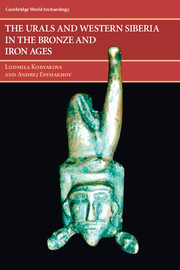Book contents
- Frontmatter
- Contents
- List of Plates, Figures, and Tables
- Foreword, by Philip L. Kohl
- Preface
- Introduction
- PART ONE THE BRONZE AGE: THE RISE OF ECONOMIC AND CULTURAL COMPLEXITY
- 1 The Development of Bronze Metallurgy
- 2 The Achievements and Collisions of the Early and Middle Bronze Age
- 3 Stabilization, Colonization, and Expansion in the Late Bronze Age
- 4 On the Eve of a New Epoch: Final Bronze Age
- PART TWO THE IRON AGE – FORMING EURASIAN INTERACTIONS
- Notes
- References
- Index
1 - The Development of Bronze Metallurgy
from PART ONE - THE BRONZE AGE: THE RISE OF ECONOMIC AND CULTURAL COMPLEXITY
Published online by Cambridge University Press: 03 February 2010
- Frontmatter
- Contents
- List of Plates, Figures, and Tables
- Foreword, by Philip L. Kohl
- Preface
- Introduction
- PART ONE THE BRONZE AGE: THE RISE OF ECONOMIC AND CULTURAL COMPLEXITY
- 1 The Development of Bronze Metallurgy
- 2 The Achievements and Collisions of the Early and Middle Bronze Age
- 3 Stabilization, Colonization, and Expansion in the Late Bronze Age
- 4 On the Eve of a New Epoch: Final Bronze Age
- PART TWO THE IRON AGE – FORMING EURASIAN INTERACTIONS
- Notes
- References
- Index
Summary
From the very beginning, Russian archaeologists studied both historical and technological aspects of ancient metallurgy. However, until recently, many Russian archaeologists regarded this categorizing of artifacts as a means of synchronization and used it primarily for cross-cultural comparisons. At present, such a narrow use of the metal material has nearly been discarded as a result of the advances of analytical studies of the technology of metal production and the work of specialists such as Yessen (Yessen & Degenom-Kovalevski 1935), Chernikov (1949, 1935), Bochkarev (1995a, 1995b), Sunchugashev (1969, 1979), Ryndina (1998), and Chernykh (1966, 1970, 1992).
Ryndina has summed up the basic approaches that relate to the problems of the beginning of the Bronze Age. She considers the cultures in which metal ornaments and thrust and cutting tools appeared only sporadically as Eneolithic. The cultures with a large number of objects made of artificial alloys can be classified firmly as Bronze Age cultures (Ryndina & Degtyareva 2002: 18).
Chernykh (1989) regards metals as a major determinative factor that resulted in great changes, apart from metallurgy, in other areas of human culture and entailed enormous consequences. He describes it in terms of the theory of metallurgical focuses and provinces, which corresponded to one or another archaeological culture. He combined the types of copper-based alloys with morphological types of metal artifacts and plotted the quantitative relationships between the different compositions that were characteristic for particular cultures.
Such observations have formed the basis for the identification of the metallurgical or metalworking centers.
- Type
- Chapter
- Information
- Publisher: Cambridge University PressPrint publication year: 2007



